|
August 1960 Electronics World
 Table of Contents
Table of Contents
Wax nostalgic about and learn from the history of early electronics. See articles
from
Electronics World, published May 1959
- December 1971. All copyrights hereby acknowledged.
|
Railroads have played a
fairly major role in communications development. Beginning with carrying letter
mail as cargo across vast distances much more quickly than horse-drawn coaches
and even Pony Express, much of the early telegraph and then telephone electric
lines were strung along rail lines. Doing so facilitated initial installation as
well as maintenance since materials and personnel could be delivered quickly and
conveniently. Many miles of old telegraph lines can still be seen lurking in the
trees and weeds along tracks all over the country. Both telegraph and wireless
communications were used to keep in contact with trains to establish location,
weather condition, equipment status, Indian uprisings, to enable messaging to
and from passengers, and to provide navigation instructions when the need arose.
The world's first
mobile radio broadcast took place on a train. This 1960 "Railroad Radio"
article in Electronics World magazine reported on the state of the art
at the time.
See also this 1944
End to
End Communications for Trains article.
Railroad Radio
 Communications by radio is increasing the
speed and efficiency with which our rail freight is handled. Communications by radio is increasing the
speed and efficiency with which our rail freight is handled.
Radio has not obsoleted the lantern. The lantern is still a very useful tool
in railroad operations but radio has made life much more pleasant for railroad personnel
and has contributed much to the more efficient operation of railroads. It is radio
plus the diesel-electric locomotive which made it possible to haul longer trains,
faster. It is in freight service, not in the operation of passenger trains, that
railroads earn most of their income. And, it is in the operation of freight trains
and the handling of freight cars that radio is of the greatest value to the railroads.
The most important application of radio in railroading is on freight trains to
enable crews in the locomotive and the caboose to communicate with each other. Before
radio, if the conductor wanted to stop the train he had no means of notifying the
engineer. His only recourse was to open an air valve which applied the brakes. This
often resulted in damage to the train. The engineer could communicate one way by
tooting his whistle if the conductor could hear it. If you have ever ridden in a
caboose, you can understand why this is an almost impossible feat.
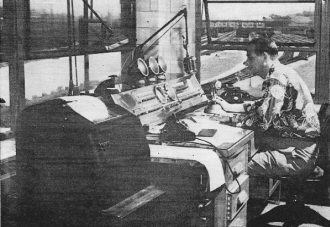
This railroad yardmaster has complete communications at his finger
tips. From his perch high above the Air Line Yard in Milwaukee, Wis., he can see
freight yard operations. By operating switch keys on the console before him, he
is able to talk with personnel on foot by means of two-way loudspeakers. He also
has radiotelephone equipment for talking with crews on the engines. In addition,
telephone lines are interconnected with the control console. At the left of the
desk is a teletypewriter unit used to type out important messages. The over-all
system thus represents an integration of radio, loudspeaker, telephone, and teletypewriter
communications, all of which make for most efficient operation.
Today, the conductor picks up his microphone to tell the engineer to "high ball"
(go ahead) as soon as the flagman is back on board after protecting a standing train.
When the engineer has a mechanical problem, he too can pick up his microphone and
tell the conductor of his troubles. Before radio, the conductor might have had to
walk a mile or more to the head end of the train to talk things over with the engineer.
Now, when a defect such as a "hot box" occurs, the defective car can be set on
a siding and the train can get under way in minutes compared to sometimes several
hours in pre-radio days. Train crews are often provided with "walkie-talkies" which
are extremely valuable in coordinating such tricky maneuvers. And the lucky flagman
who has a walkie-talkie won't get left in the wilderness, which has often happened
in the past. He can use his radio to tell the engineer to get ready to go but wait
until he is actually on board.
Before radio, train crews were out of touch with the outside world except when
they picked up written messages as they passed wayside towers. Radio has not obsoleted
the written train order, but radio has certainly simplified the passage of vital
information.
Railroad radio received its initial impetus when the Rock Island Line applied
for a permit to experiment with two-way operation. This application, filed in April
of 1944, was granted in February 1945. The first permanent authorization for railroad
radio service was issued to the Denver & Rio Grande Western in February 1946.
Permission for hump-yard communications was granted in August 1946 to the Baltimore &
Ohio for its New Castle, Pa. yards.
Now thousands of miles of railroad trackage are covered by radio communication
with base stations spaced 10 to 50 miles apart along the right-of-way. Train crews
can now keep in touch with wayside tower operators and sometimes directly with the
dispatcher many miles away. And, when wire lines are down, wayside towers can use
their radio stations for communicating with each other.
Main Line Radio
A decade ago, radio was installed by the short but progressive South Shore Line
which operates high-speed electric passenger service as well as freight trains between
Chicago and South Bend. It was a newsworthy event because it was a case of the tail
wagging the dog. This short-line railroad was the first in the United States to
provide radio communication from one end of its system to the other. The installation
was also significant because it was the first to use automatic relay stations to
extend coverage. No wire lines were required for interconnecting the three base
stations, as is ordinarily the case in such installations.
The example set by the South Shore Line probably had an effect on the thinking
of some of the larger systems who saw how valuable radio could be to a railroad.
Today, many of the major roads have extensive right-of-way radio systems. While
these radio stations are often controlled locally or from a nearby telegraph tower,
many roads use wire lines for interconnecting wayside radio stations with the dispatcher's
office. Various techniques are used for selecting wayside radio stations individually
from the dispatcher's office. The dispatcher may push a button or dial a number
to select a radio station nearest the train with whose crew he wishes to communicate.
One of the first long-haul, right-of-way radio systems utilizing selective control
of base stations was installed by the Northern Pacific Railway. The Erie was the
first to install a radio system on the run between Chicago and New York.
Yard Communications
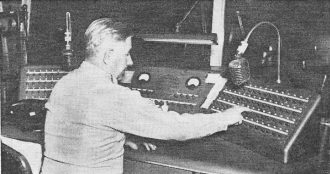
Yardmaster's tower in Barr Yard of B & O railroad near Chicago
with its intercom, radio, and complete paging facilities.
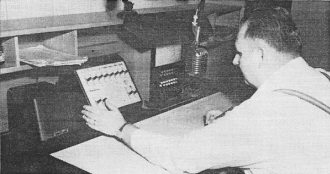
The modern train dispatcher can keep in touch with commuter trains
as well as profit-making freights with two-way radio.
Communication within a railroad marshaling yard before the electron era consisted
of direct word of mouth, sometimes augmented by colored light signals. Electronics
first made its appearance in the form of loudspeaker paging systems. This was one-way
communication. However, two-way communication is required in order to affirm that
an order has been received so telephones were used by yard personnel for replying.
Today's modern railroad yard is a maze of electronic gear. The one-way loudspeaker
paging system is still there but personnel now reply through tiny hand-carried portable
radio transmitters called "Dick Tracy" units by railroaders. The yardmaster switches
on the paging loudspeakers in the specific area where he expects to locate the desired
individual. Or, if he is apt to be almost anywhere, the yardmaster might page over
the entire yard area.
When a yard employee hears his name called over the paging system, he merely
holds the "Dick Tracy" unit near his lips and acknowledges the page. The feeble
radio signal is picked up by a nearby remote radio receiver whose audio output is
fed to the yard-master's office. Thus, a two-way conversation may be held, using
audio to talk out and radio to talk in.
In addition to a paging system, the modern railroad yard is provided with a gigantic
intercom system, some consisting of as many as 200 or more remote talk-back loudspeakers.
These remote talk-back speakers are connected through underground cables to one
or more control consoles, which resemble a pipe organ.
The yardmaster may page over the intercom system too. He flicks selector keys
which group several talk-back speakers together, permitting low-level paging over
selected areas. The paged person, in replying, merely steps up to the nearest talk-back
speaker and pushes a signal button. This lights an identification lamp on the yardmaster's
control console. The yardmaster then flicks the key associated with that lamp, switching
that specific talk-back speaker into the circuit. The yard-master talks out by speaking
into a microphone and stepping on a foot sw1tch under the console. To listen, he
relieves the pressure on the foot switch.
The yardmaster can locate crews working in the yard area by flicking talk-back
speaker selector keys on his console, one at a time, judging the location of the
crew by listening to the incoming sounds.
There are several base radio stations in a typical, modern rail yard. One may
be used for supervision of operations at the northbound hump, another at the southbound
hump, a third for communicating with trains approaching or leaving the yard and
still another for communicating with work crews and motor vehicles.
Generally, each of the base stations has its own control point since each is
used in its own individual operation. However, in order to give the yardmaster complete
control of all operations, the control console in one or more yard towers may also
serve as an additional control point for all of the radio stations.
In the modern yard, the yardmaster has his own office on the top floor of a tall
tower, not unlike an airport control tower, from which vantage point he can see
the entire yard. He sits at a giant console which opens avenues of communication
to yard personnel via a paging system, intercom system, two-way radio, and telephone
circuits. Each group of paging speakers, individual talk-back speakers, base radio
stations, and several telephone circuits all terminate in the console and may be
activated by merely flicking the appropriate selector key.
Checking Cars
A few years ago, the car checker, who notes the numbers of all freight cars entering
a yard, often had a miserable time trying to write down numbers in the rain or snow.
Today, he carries a walkie-talkie with him and reads off the numbers which are taken
down by a clerk inside a warm, cozy office, who sometimes tape records them for
future reference. Here again, a separate base station is used for car checking so
as not to clutter radio channels that are needed for other operations.
Equipment
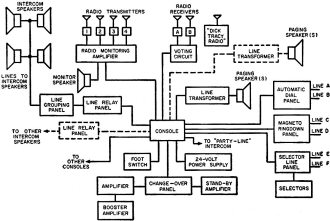
Block diagram of a typical railroad yard communications system.
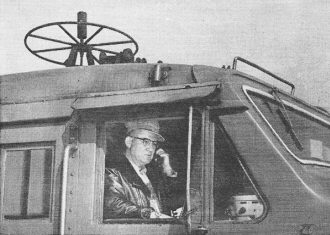
Train engineers can keep in touch with wayside towers and can
summon aid when needed if they have two-way radio installation.
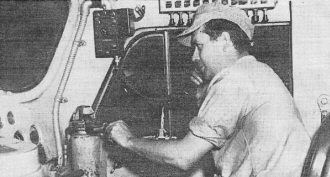
Radiotelephone handset being used by engineer of diesel-electric
freight locomotive on the B & O's radio traffic control system.
Railroad radio equipment is packaged in single-unit as well as in three-unit
assemblies. The single-unit combines transmitter, receiver, and power supply in
a single enclosure. The three-unit sets consist of a separately housed transmitter,
receiver, and power supply.
While electrically similar to mobile radio equipment for use in motor vehicles,
railroad radio equipment has to be more ruggedly constructed. The audio power output
of a vehicular radio unit is about one to two watts, whereas railroad radio units
deliver from five to ten watts of audio, required to override the ambient noise
encountered in cabooses in particular. The modern diesel locomotive, on the other
hand, rides almost as smoothly as a Pullman car and is very quiet compared to the
obsolete "iron horse."
Power Sources
The typical diesel locomotive is equipped with a 64-volt battery which is used
as the source of power for radio equipment. Early locomotive installations used
radio units designed for operation from 117-volts a.c. A rotary or vibrator type
converter is used for converting the 64-volts d.c. to 117-volts a.c. Later, railroad
radio units were introduced which contain a vibrator power supply that permits direct
operation from the 64-volt battery, eliminating the need for a converter.
The Erie railroad equipped its cabooses with 32-volt batteries of the same type
as used on passenger coaches. An axle-driven generator keeps the battery charged.
Because of the high cost of 32-volt batteries, the Gulf, Mobile & Ohio Railroad
experimented with 6-volt automobile batteries kept charged by an ordinary automotive
generator which was driven by the wheels of the caboose. Later, most of the railroads
settled on using a 12-volt truck battery and an axle-driven rectifier-alternator.
Passenger cars and baggage cars are generally provided with a 32-volt battery
and an axle-driven generator. Some cars, however, are equipped with 64-volt or 110-volt
batteries.
Communicating Frequencies
Most of the railroad radio systems in service operate in the 152-162 mc. band
where 91 channels have been allocated to the Railroad Radio Service. Four channels
are available in the 450-460 mc. band for use by the railroads and five channels
are available in the 27 mc. band, but as this is written, so far there have been
few takers. The reason for this is that the railroads prefer maximum interchangeability
of equipment and do not want to mix brands or types. For example, a railroad that
installs one brand of equipment generally sticks with the same brand when expanding.
While the railroads have been extremely fortunate in having so many channels
assigned to them, the 152-162 mc. band does not offer a wholly satisfactory solution
under all conditions. In some mountainous, densely wooded areas, for example, the
range achieved when operating in the 152-162 mc. band is inadequate. Police radio
systems operating in the same areas in the 25-50 mc. band enjoy much greater coverage.
Sometimes such special installations are impractical because of cost and incompatibility
with 152-162 me. systems in use on the rest of the railroad.
Some railroads are, however, making use of the 450-470 mc. band in freight pick-up
and delivery operations. Trucks, operated by railroad subsidiaries, are equipped
with conventional, vehicular-type 450 mc. mobile radio units for communicating with
dispatchers and expediting the handling of freight that is less-than-carload-lot.
Maintenance
Most railroads buy their own radio equipment which is installed and maintained
by railroad personnel. A few have leased equipment from telephone companies or independent
distributors of radio equipment. While most railroads handle their own radio maintenance,
even those with extensive communications departments sometimes farm out radio servicing
in certain areas to independent service dealers.
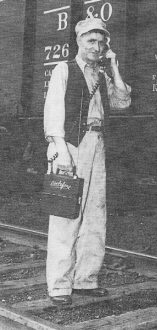
The walkie-talkie radio permits freight train conductor to remain
in constant touch with the train's crew when the train stops.
Radio equipment is seldom serviced on board a train. Instead, spare equipment
is installed and the original equipment is brought into a shop for overhaul. Field
servicing is generally limited to checking of the antenna system and electric power
source.
Now that the railroads are making wide use of electronic devices, there are opportunities
within the railroad industry for electronic technicians and engineers. The pay rate
is good compared to many other industries but the biggest attraction is the security
offered by the railroads. There is a pension plan which has deterred many from leaving
railroad jobs for other fields. Those interested in railroad employment should get
in touch with the superintendent of communications of the railroad with which they
would like to become associated.
The Future
In the not-too-distant future, crews of terminal switching locomotives will be
able to dial a number on an ordinary telephone dial when approaching a siding protected
by a gate. When dialing, the radio transmitter in the locomotive sends out a combination
of pulses which are picked up by a radio receiver near the closed gate. The pulses
unlock a decoder which starts an automatic gate opening mechanism. The locomotive
moves into the plant area through the open gate without first having to stop and
wait until the gate is opened manually. Upon completion of the work in the plant
area, the crew dials another number and the gate closes automatically.
Closed-circuit television is already being used in some yards, obviating the
need for having a car checker stand out in the weather to read car numbers.
TV is also being used for inspecting the mechanical condition of cars as well
as observing the over-all movements in a yard.
Further railroad automation is coming. Still unsolved is the problem of identifying
freight cars automatically as they enter a yard. While push-buttons are used for
controlling the movements of freight cars as they roll down the hump, it is still
necessary to have human beings identify individual freight cars. This is often difficult
when the number is almost, if not completely, illegible.
It has been suggested that cars be marked with colored strips in different combinations.
The coded combinations are read by a photocell and the information is either stored
or displayed by a computer. Another proposed system would provide for coding of
cars with radio-active paints using a Geiger counter for reading the numbers.
The use of microwave systems by railroads is expected to expand materially. Much
of the open-wire pole line plant operated by the railroads, about 250,000 miles
of lines, will require re-placement or rehabilitation. Maximum use of these wire
lines is being made by many railroads which have installed modern telephone and
telegraph carrier systems. One pair of wires, equipped with a modern carrier system,
can handle up to a dozen telephone conversations simultaneously. But, even this
is not sufficient to accommodate the growing need for communications. Hence, microwave
systems which can handle up to 200 voice channels offer freedom from communications
congestion.
It is the transistor, however, which is expected to revolutionize railroad communications
for the second time since World War II. Transistorized telephone carrier and voice
repeaters, which can be operated from batteries, can be installed in remote locations
where reliable utility power is not available. Even the smallest yards and some
sidings where electric power is not available can be equipped with paging and intercom
systems utilizing battery-operated transistorized amplifiers.
Partially transistorized railroad equipment is already available. Transistors
are being used in audio output stages and in lieu of vibrators in power supplies.
But it is the all-transistorized railroad radio that is being awaited by the industry.
Imagine a caboose radio the size of a portable typewriter, perhaps even smaller,
which will operate from a pair of lantern batteries or even solar cells. The vibrator,
axle-drive assembly, storage battery, and charging generator will then be only memories.
Based on observations of the present rate of progress of the electronics art, the
all-transistorized railroad radio is not far away.
Posted January 5, 2023
|
















